History
Beginnings
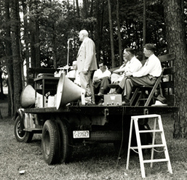 Judge Harley Langdale of Valdosta, Georgia, along with 900 other men from the southern turpentine industry, established the American Turpentine Farmers Association (ATFA) on March 18, 1936. The association was formed to represent the interests of gum naval stores factors, producers, and dealers in the United States "turpentine belt" (Georgia, Alabama, Florida, South Carolina, North Carolina, Tennessee, Kentucky, Virginia, Mississippi, Louisiana, Texas). ATFA revived the gum naval stores industry, comprised of rosin and turpentine, by organizing gum producers in order to stabilize the market; improving marketing and production of gum turpentine and its by-products; conserving and promoting the conservation of pine forests; building a stronger relationship among businesses and the government; and taking control of surplus gum while initiating a loan program for its members. Ultimately, ATFA strived to show that turpentining was an agricultural, not an industrial process.
Judge Harley Langdale of Valdosta, Georgia, along with 900 other men from the southern turpentine industry, established the American Turpentine Farmers Association (ATFA) on March 18, 1936. The association was formed to represent the interests of gum naval stores factors, producers, and dealers in the United States "turpentine belt" (Georgia, Alabama, Florida, South Carolina, North Carolina, Tennessee, Kentucky, Virginia, Mississippi, Louisiana, Texas). ATFA revived the gum naval stores industry, comprised of rosin and turpentine, by organizing gum producers in order to stabilize the market; improving marketing and production of gum turpentine and its by-products; conserving and promoting the conservation of pine forests; building a stronger relationship among businesses and the government; and taking control of surplus gum while initiating a loan program for its members. Ultimately, ATFA strived to show that turpentining was an agricultural, not an industrial process.
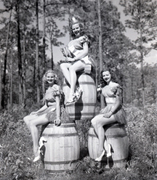
In 1936, ATFA members elected their first Board of Directors to serve a one-year term and established their headquarters in Valdosta, Georgia. The inaugural board included Judge Harley Langdale (president), Robert M. Newton (vice-president), Colin Kelly (secretary/treasurer), J. E. Dyal, W. L. Rhodes, M. C. Stallworth, J. B. Davis, George W. Hall, Albert F. Bullard, and James Fowler. In October 1937, the association began hosting annual board meetings and conventions with a variety of activities for members and their families, including dances, barbeques, and stag dinners. In 1940, a beauty pageant was added to the festivities where young ladies wore bathing suits made from pine needles and the winner received a pine needle tiara. Mary Newton, a student of Georgia State College for Women, was named the first Miss Spirit of Turpentine and had the honor of representing ATFA at parades and festivals throughout the state.
Sticky Politics
Soon after ATFA’s founding, the Agricultural Adjustment Act of 1933, which encouraged the reduction of staple crops in order to raise market prices, was deemed unconstitutional. In response, Congress passed the Soil Conservation and Domestic Allotment Act, which created the Naval Stores Conservation Program to encourage turpentiners to decrease their production acreage and be reimbursed for the loss. The Agricultural Adjustment Act of 1938 made loans available to farmers during abundant seasons, set market prices, and provided storage for surplus crops which could then be distributed when commodities became scarce. The goal of this legislation was to ensure that the market remained stable and market prices did not experience extreme fluctuations throughout the harvest season. The conservation programs helped keep inflation under control and provided some financial relief for ATFA members who were being asked to shrink their production output.
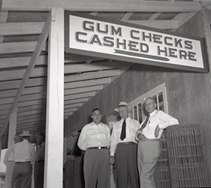 Also in 1938, the Gum Naval Stores Loan and Purchase Program was enacted to provide loans through the Commodity Credit Corporation (CCC) to qualifying naval stores farmers who were adhering to the stipulations of the Naval Stores Conservation Program. ATFA acted as the field administrator for these loans and granted cash advances to its qualifying members. The loan values were based on bulk gallons of turpentine and rosin, grades G or higher, but no loans were made on turpentine in barrels. Oleoresin, a mixture of resin and oil, stored at distillation plants was also eligible for this loan program. The conservation program was relaxed during World War II when the War Production Board needed ATFA members to increase production to 450,000 units. While increases in production were important to the U.S. war effort, they were more vital to Great Britain which had significantly depleted stocks. The Lend-Lease Act of 1941 allowed for the U.S. to send materials to the Allies without receiving payment, this enabling ATFA to administer large shipments of gum turpentine and rosin stored in Valdosta, Georgia to Great Britain to help supplement their supply.
Also in 1938, the Gum Naval Stores Loan and Purchase Program was enacted to provide loans through the Commodity Credit Corporation (CCC) to qualifying naval stores farmers who were adhering to the stipulations of the Naval Stores Conservation Program. ATFA acted as the field administrator for these loans and granted cash advances to its qualifying members. The loan values were based on bulk gallons of turpentine and rosin, grades G or higher, but no loans were made on turpentine in barrels. Oleoresin, a mixture of resin and oil, stored at distillation plants was also eligible for this loan program. The conservation program was relaxed during World War II when the War Production Board needed ATFA members to increase production to 450,000 units. While increases in production were important to the U.S. war effort, they were more vital to Great Britain which had significantly depleted stocks. The Lend-Lease Act of 1941 allowed for the U.S. to send materials to the Allies without receiving payment, this enabling ATFA to administer large shipments of gum turpentine and rosin stored in Valdosta, Georgia to Great Britain to help supplement their supply.
Throughout its history, ATFA regularly sent delegations to Washington, D.C. to lobby for legislation that favored the turpentine industry. The organization also fought against laws that hampered production and made attracting workers difficult. Attracting and maintaining turpentine workers was crucial, especially during the war when ATFA members were under pressure to not only meet but exceed production expectations. There were four acts of Congress that had a tremendous affect on the turpentine labor force: Social Security Act (1935), Frazier-Lempke Act (1941), Wage-Hour Bill (1939), and an amendment to the Workmen’s Compensation Act (1943).
One of the primary goals of ATFA was to ensure that the Social Security Act of 1935 was amended to include its members as tax exempt workers. From its inception the act exempted farmers from taxation but did not exempt turpentiners because it classified them as industrial workers. ATFA successfully lobbied to have their workers reclassified as agricultural and received an exemption that remained in affect until Congress amended the act in 1958. The fight for social security exemption led to the Frazier-Lempke Act, passed in 1941, which granted turpentine workers the same employee rights and benefits as all other agricultural farmers. The association also lobbied to have their workers be exempt from the 1939 Wage-Hour Bill. This legislation allowed farmers and seasonal workers to avoid increases to the minimum wage and the implementation of a shortened work week. Turpentiners were not initially included, and thus were subject to new wages and a limited work week that is impractical for an industry with a limited harvest season. The ATFA Board of Directors sent a plea to all southern congressmen to add an amendment to the bill, protecting the turpentine industry in the same way they protected farmers. As originally written, the bill would have had a detrimental impact on already strained industry with inflated prices that could not withstand a labor cost increase. Another victory for association members came in 1943, when Congress declared gum naval stores producers were no longer subject to the Workmen's Compensation Act. All of this legislation allowed for the turpentine industry to prosper during the post-war period and experience years of peak production in the late 1940s.
Tapping Into New Technologies
By the 1940s, technology had transformed the Southern turpentine industry, making it more productive and cost effective. The development of the "Olustee process", which introduced steam into the distillation process, made the processing of gum turpentine more efficient. It became a technological innovation that changed the very nature of the turpentine business. A modern, centralized gum distillery, the first of its kind in the South, was built in Valdosta, Georgia in 1943. The following year, Turpentine and Rosin Factors, Inc. opened in Valdosta, producing the world's largest volume of business in bottled turpentine. This distillery was the most technologically advanced turpentine packaging plant established thus far and, according to the AT-FA Journal signified, "a new era in the gum turpentine industry." In 1957, the U.S. Department of Agriculture’s (USDA) Naval Stores Station in Olustee National Forest, Florida developed a continuous steam still to increase turpentine and rosin production. Three years later, central steam stills had entirely replaced individual fire stills, speeding up the distillation process and lowering costs. 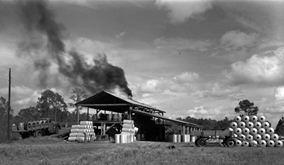
ATFA was a great supporter of technological improvements in the industry and financed research and development throughout the turpentine belt. ATFA’s members were primarily interested in investing in ways to increase gum production, decreasing the overall damage done to the trees during gum harvest, and methods for increased mechanization. While acid paste had been used to increase gum production since the 1940s, research conducted at the Olustee Naval Stores Station improved the paste solution, making it safer for workers to handle and less damaging to trees. The station began collaborating with the Georgia Agricultural Extension Service to co-sponsor demonstrations on the proper use and benefits of acid paste throughout the state. ATFA also urged its members to adopt new techniques that allowed more of the tree crop to be conserved for use in the timber industry. These techniques involved the use of paper and plastic cups, instead of traditional metal cups, and the use of soft metal staples that would not damage timber machinery. While turpentine farming remained a very labor intense industry, in the 1960s mechanizations eased the workload. Notable advancements included pneumatic chipping tools and staple guns, mechanical gum harvesters, and new vehicles for carrying heavy loads over uneven ground. Each innovation allowed for greater efficiency and increased safety for workers.
ATFA was not only interested in developing a technologically advanced turpentine industry, but also focused on developments for new industrial uses of gum turpentine and rosin. During the early 1940s, the association contracted with G&A Laboratories, Inc. in Savannah, Georgia to develop new by-products of gum turpentine. In 1953, the USDA began working with Armour Research Foundation and later the Georgia Institute of Technology, to study ways to make pinic acid, an ingredient used in many industrial products, from a turpentine component called alpha pinene. The following year the USDA developed a new class of hydroperoxides from gum rosin derivatives, one of which sped the process of rubber production. By the mid-1960s, new types of plastic were being developed from pine gum rosin.
"Spirit" Advertising
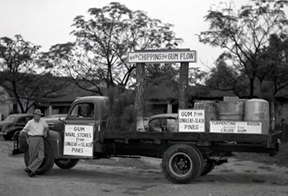 AFTA's establishment ushered in a new era of visibility for the turpentine industry. In 1937, ATFA began the Gum Turpentine National Advertising Campaign, which improved the accessibility of turpentine by marketing it in small containers more appropriate for household use, and educating businesses and the general public about the various uses of turpentine. The campaign included color advertisements that appeared in national publications, the creation of an official AT-FA Journal containing articles related to the naval stores industry, an exhibit at the 1939 World’s Fair in New York, and the creation of the official “ATFA Seal of Approval” and distinctive green bottle packaging. There were even national radio advertisements. The text below comes from one such advertisement broadcast on CBS on April 21, 1943:
AFTA's establishment ushered in a new era of visibility for the turpentine industry. In 1937, ATFA began the Gum Turpentine National Advertising Campaign, which improved the accessibility of turpentine by marketing it in small containers more appropriate for household use, and educating businesses and the general public about the various uses of turpentine. The campaign included color advertisements that appeared in national publications, the creation of an official AT-FA Journal containing articles related to the naval stores industry, an exhibit at the 1939 World’s Fair in New York, and the creation of the official “ATFA Seal of Approval” and distinctive green bottle packaging. There were even national radio advertisements. The text below comes from one such advertisement broadcast on CBS on April 21, 1943:
"From the great fragrant pine forests of the romantic south comes pure gum spirits of turpentine. This product is refined from the sap of the living pine trees, and it’s called ‘The Universal Household Cleanser.’ Keep a Duraglas Bottle of gum spirits of turpentine on hand at all times. You’ll use it to thin paint and varnish, of course, and to clean paint brushes and remove paint spots from any surface. Besides that, it’s a great help in cleaning tiles floors, and all porcelain fixtures in the bath room. When you ask your dealer for gum turpentine, get it in a Duraglas bottle made by Owens-Illinois Glass Company."
The publicity campaign was a great success and, as a result, numerous county agencies and city councils throughout the turpentine belt passed resolutions to use only gum spirits of turpentine as a solvent for painting projects on their properties. Other individuals such as William Capers Rice, mayor of Vidalia, Georgia, were inspired to organize their own agricultural co-operatives. Rice founded a competing organization, the Gum Turpentine Farmers Cooperative Association, which three years later became an ATFA affiliate member.
In 1942, members proposed that ATFA help fund a film about gum naval stores to provide more information about turpentine production to the public. The board of directors agreed to fund the project and the film, Suwanee Pine, was produced by the Georgia Cooperative Extension Service and directed by J. Aubrey Smith. Suwanee Pine detailed the entire turpentine process, from the initial tapping of the pine trees through the distillation process to the numerous usages of rosin and turpentine by consumers. Extension Service participants included Aubrey Smith, John Martin, narrator, and Edward Craig, director of the musical score. On May 18, 1944, the first public screening of Suwanee Pine at the Ritz Theatre in Valdosta opened to a packed house. The premiere was accompanied by a parade held in downtown Valdosta. Walter S. Brown, director of the Extension Service, praised ATFA for their support of the film. In 1957, another film, More Profit By Gum!, supported by ATFA and directed by Smith won the American Association of Agricultural College Editors' Farm Film Award. Both of these films were distributed and shown to 4-H Clubs, civic organizations and agricultural demonstration clubs, and conventions and distributor meetings across the country.
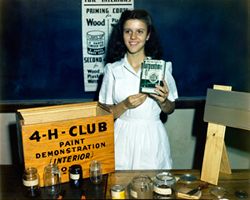 ATFA and 4-H
ATFA and 4-H
Since its establishment, ATFA has always been a great supporter of 4-H clubs throughout the United States. They began sponsoring 4-H Club Paint Team Demonstrations in June of 1941 at the Remington Home Demonstration Club, a home economics and agricultural organization. Other co-sponsors included Georgia 4-H, Georgia Agricultural Extension Service, Lead Industries, and Lumber Products Manufacturing. At these events, boys and girls from 286 4-H Club Paint Teams instructed audiences in Kansas, Iowa, Wisconsin, Oklahoma, and Georgia, on good painting practices. Every 4-H Club Paint Team kit included a quart of ATFA gum turpentine, and the importance of gum turpentine as a paint thinner was stressed during the demonstrations. By 1942, 4-H clubs in sixteen states were taking part in the paint club demonstrations. ATFA also sponsored the 4-H Club Naval Stores Camp, encouraging knowledge about the industry, in Lowndes County, Georgia, from 1949 to 1970. On September 30, 1953, Georgia 4-H Club showed its appreciation for all of ATFA's contributions by dedicating cottage number nine at the Rock Eagle 4-H Center near Eatonton, Georgia, to Judge Harley Langdale with a plaque bearing his name and tracing the history of ATFA.
ATFA's Quiet Decline
In 1937, the U.S. was responsible for 53% of rosin and turpentine produced worldwide, but by the mid-1960s production had decreased significantly. In 1949, ATFA generated a forty-three million dollar income and supported over four thousand members and more than eight thousand gum producers. However, many producers began turning to other industries that generated more profit and were less labor intensive, such as pulpwood. Competitive international markets along with forest fires that raged through Georgia in the early 1950s did little to help matters. By 1966, gum turpentine production had dropped to an all time low, and only nineteen processing plants remained open.
Four major factors contributed to the virtual extinction of the gum turpentine industry in the U.S. First there was the competition from wood naval stores, petroleum based products, and sulfate naval stores, specifically sulfate rosin, or "tall oil", production. Labor and production costs, which continued to increase while demand did not, also played a significant role. Workers gradually moved from turpentine camps to pulpwood operations creating a huge labor shortage. Even one of ATFA's own members, Turpentine & Rosin Factors, Inc., licensed petroleum thinner to be used as a substitute for turpentine.
ATFA did make several attempts to prevent the decline of the turpentine industry but none were successful. The group continued organizing research projects to find more by-products of gum turpentine that industries and the general public might want to purchase. In 1953, Langdale appointed an Advisory Committee on Research made up of members from ATFA and the Gum Processors Association to oversee new research on gum turpentine.
ATFA also continually urged its membership, both through their journal and at annual meetings, to conserve trees, increase production, and provide incentives to find and keep a labor force. In 1954, the group began holding educational field meetings, supporting these practices, for turpentine processors. While these efforts were successful and the use of gum rosin for paper production did increase in the 1950s, the introduction of new methods only made a small dent in the rapidly falling numbers for gum production and consumption. ATFA then chartered the Pine Gum Development Corporation whose responsibility was to oversee the association's CCC stocks and surplus gum turpentine and rosin. The following year, members voted to place all their gum turpentine into the federal loan program until prices stabilized.
In 1965, Harley Langdale ended an era in ATFA history by stepping down as president; after twenty-nine years of service. Jim L. Gillis, Jr. of Soperton, Georgia was elected as the second president of the association; he would also be its last. By the end of 1967, the Olustee lab had stopped researching pine gum entirely and the government began liquidating its gum naval stores. The last AT-FA Journal was distributed two years later, at which time only 1,222 gum producers remained in the United States. Judge Harley Langdale died in April of 1972 and the company he founded, Langdale Company, Inc., increasingly focused on the lumber industry rather than turpentine. The centralized gum distillery in Valdosta shut down in the mid 1970s, and ATFA discontinued their traditional annual meeting and held four annual regional meetings in its place by 1975 due to a decrease in attendance. As a result, the Miss Spirits of Turpentine beauty pageant was also cancelled. The new Queen was thereafter chosen from among contestants in the Miss Georgia Forestry Contest at the Georgia Forestry Commission Convention. The final Queen, Amy Sarah Gowen, was chosen in 1995.
During the 1980s, with ATFA's decline and the relative end of turpentine production in the States, Brazil, Portugal, China, and Indonesia gradually became the major world producers of gum naval stores. In 1980, the USDA quit reporting gum production and prices, the Gum Naval Stores Loan and Purchase Program ground to a halt, and federal gum price support ceased. At that time, only three hundred gum producers remained in the U.S. The ATFA office relocated from Valdosta to the Georgia Forestry Commission's McRae District Office in 1996, and the last bucket of Georgia gum for commercial turpentine was drawn in 2001.
The Georgia Agrirama, State Museum of Agriculture, in Tifton has become one of the primary vehicles for keeping ATFA's history alive since the virtual extinction of turpentine production in the state. In 1982, the Agrirama held the first annual Naval Stores Day and began operating its own turpentine still, which continues to be run once a year. ATFA transferred its files to the Agrirama in 1993; they are still being honored there to this day.
